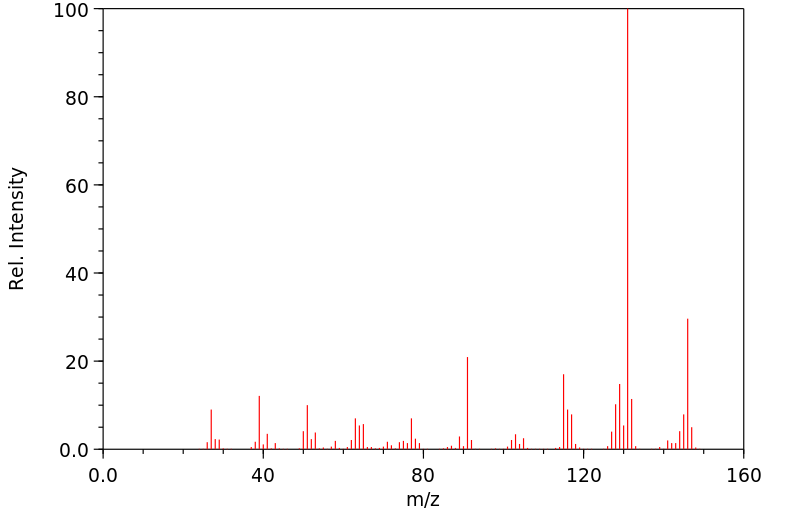1,2-二甲基-2,3-二氢-1H-茚 | 17057-82-8
中文名称
1,2-二甲基-2,3-二氢-1H-茚
中文别名
1,2-二甲基茚满
英文名称
1H-Indene, 2,3-dihydro-1,2-dimethyl-
英文别名
1,2-dimethyl-2,3-dihydro-1H-indene
CAS
17057-82-8
化学式
C11H14
mdl
——
分子量
146.232
InChiKey
DIUGYPAVPJILFZ-UHFFFAOYSA-N
BEILSTEIN
——
EINECS
——
-
物化性质
-
计算性质
-
ADMET
-
安全信息
-
SDS
-
制备方法与用途
-
上下游信息
-
文献信息
-
表征谱图
-
同类化合物
-
相关功能分类
-
相关结构分类
物化性质
-
熔点:-1.5°C (estimate)
-
沸点:225.87°C (rough estimate)
-
密度:0.9270
-
保留指数:1130.1;1168.7;1130
-
稳定性/保质期:
存在于主流烟气中。
计算性质
-
辛醇/水分配系数(LogP):3.3
-
重原子数:11
-
可旋转键数:0
-
环数:2.0
-
sp3杂化的碳原子比例:0.45
-
拓扑面积:0
-
氢给体数:0
-
氢受体数:0
安全信息
-
海关编码:2902909090
SDS
上下游信息
-
上游原料
中文名称 英文名称 CAS号 化学式 分子量 二甲基茚满醇 1-Oxy-1.2-dimethyl-hydrinden 94689-31-3 C11H14O 162.232
反应信息
-
作为反应物:描述:参考文献:名称:Zur Kenntnis der Sesquiterpene;。(47. Mitteilung)。合成单和二甲基az摘要:DOI:10.1002/hlca.19410240166
-
作为产物:描述:参考文献:名称:Preparation and Properties of Some Methylated Indans摘要:DOI:10.1021/ac60081a003
文献信息
-
Mononuclear ruthenium complex and organic synthesis reaction using same申请人:KYUSHU UNIVERSITY, NATIONAL UNIVERSITY CORPORATION公开号:US09884316B2公开(公告)日:2018-02-06A neutral or cationic mononuclear ruthenium divalent complex represented by formula (1) can actualize exceptional catalytic activity in at least one reaction among a hydrosilylation reaction, hydrogenation reaction, and carbonyl compound reduction reaction. (In the formula, R1-R6 each independently represent a hydrogen atom or an alkyl group, aryl group, aralkyl group, organooxy group, monoorganoamino group, diorganoamino group, monoorganophosphino group, diorganophosphino group, monoorganosilyl group, diorganosilyl group, triorganosilyl group, or organothio group optionally substituted by X; at least one pair comprising any of R1-R3 and any of R4-R6 together represents a crosslinkable substituent; X represents a halogen atom, organooxy group, monoorganoamino group, diorganoamino group, or organothio group; L each independently represent a two-electron ligand other than CO and thiourea ligands; two L may bond to each other; and m represents an integer of 3 or 4.)
-
Mononuclear iron complex and organic synthesis reaction using same申请人:KYUSHU UNIVERSITY, NATIONAL UNIVERSITY CORPORATION公开号:US10363551B2公开(公告)日:2019-07-30A mononuclear iron bivalent complex having iron-silicon bonds, which is represented by formula (1), can exhibit an excellent catalytic activity in at least one reaction selected from three reactions, i.e., a hydrosilylation reaction, a hydrogenation reaction and a reaction for reducing a carbonyl compound. (In the formula, R1 to R6 independently represent a hydrogen atom, an alkyl group which may be substituted by X, or the like; X represents a halogen atom, or the like; L1 represents at least one two-electron ligand selected from an isonitrile ligand, an amine ligand, an imine ligand, a nitrogenated heterocyclic ring, a phosphine ligand, a phosphite ligand and a sulfide ligand, wherein, when multiple L1's are present, two L1's may be bonded to each other; L2 represents a two-electron ligand that is different from a CO ligand or the above-mentioned L1, wherein, when multiple L2's are present, two L2's may be bonded to each other; and m1 represents an integer of 1 to 4 and m2 represents an integer of 0 to 3, wherein the sum total of m1 and m2 (i.e., m1+m2) satisfies 3 or 4.)
-
Recyclable cobalt(0) nanoparticle catalysts for hydrogenations作者:Philipp Büschelberger、Efrain Reyes-Rodriguez、Christian Schöttle、Jens Treptow、Claus Feldmann、Axel Jacobi von Wangelin、Robert WolfDOI:10.1039/c8cy00595h日期:——The search for new hydrogenation catalysts that replace noble metals is largely driven by sustainability concerns and the distinct mechanistic features of 3d transition metals. Several combinations of cobalt precursors and specific ligands in the presence of reductants or under high-thermal conditions were reported to provide active hydrogenation catalysts. This study reports a new method of preparation
-
Amine‐Borane Dehydrogenation and Transfer Hydrogenation Catalyzed by α‐Diimine Cobaltates作者:Thomas M. Maier、Sebastian Sandl、Ilya G. Shenderovich、Axel Jacobi von Wangelin、Jan J. Weigand、Robert WolfDOI:10.1002/chem.201804811日期:2019.1.2catalyze the dehydrogenation of several amine‐boranes. Based on the excellent catalytic properties, an especially effective transfer hydrogenation protocol for challenging olefins, imines, and N‐heteroarenes was developed. NH3BH3 was used as a dihydrogen surrogate, which transferred up to two equivalents of H2 per NH3BH3. Detailed spectroscopic and mechanistic studies are presented, which document the rate
-
Alkene Hydrogenations by Soluble Iron Nanocluster Catalysts作者:Tim N. Gieshoff、Uttam Chakraborty、Matteo Villa、Axel Jacobi von WangelinDOI:10.1002/anie.201612548日期:2017.3.20sustainable synthesis. Alkene hydrogenations have so far been most effectively performed by noble metal catalysts. This study reports an iron‐catalyzed hydrogenation protocol for tri‐ and tetra‐substituted alkenes of unprecedented activity and scope under mild conditions (1–4 bar H2, 20 °C). Instructive snapshots at the interface of homogeneous and heterogeneous iron catalysis were recorded by the isolation
表征谱图
-
氢谱1HNMR
-
质谱MS
-
碳谱13CNMR
-
红外IR
-
拉曼Raman
-
峰位数据
-
峰位匹配
-
表征信息
同类化合物
(S)-7,7-双[(4S)-(苯基)恶唑-2-基)]-2,2,3,3-四氢-1,1-螺双茚满
(R)-7,7-双[(4S)-(苯基)恶唑-2-基)]-2,2,3,3-四氢-1,1-螺双茚满
(4S,5R)-3,3a,8,8a-四氢茚并[1,2-d]-1,2,3-氧杂噻唑-2,2-二氧化物-3-羧酸叔丁酯
(3aS,8aR)-2-(吡啶-2-基)-8,8a-二氢-3aH-茚并[1,2-d]恶唑
(3aS,3''aS,8aR,8''aR)-2,2''-环戊二烯双[3a,8a-二氢-8H-茚并[1,2-d]恶唑]
(1α,1'R,4β)-4-甲氧基-5''-甲基-6'-[5-(1-丙炔基-1)-3-吡啶基]双螺[环己烷-1,2'-[2H]indene
齐洛那平
鼠完
麝香
风铃醇
颜料黄138
顺式-1,6-二甲基-3-(4-甲基苯基)茚满
雷美替胺杂质9
雷美替胺杂质24
雷美替胺杂质14
雷美替胺杂质13
雷美替胺杂质10
雷美替胺杂质
雷美替胺杂质
雷美替胺杂质
雷美替胺杂质
雷美替胺杂质
雷美替胺
雷沙吉兰相关化合物HCl
雷沙吉兰杂质8
雷沙吉兰杂质5
雷沙吉兰杂质4
雷沙吉兰杂质3
雷沙吉兰杂质16
雷沙吉兰杂质15
雷沙吉兰杂质12
雷沙吉兰杂质1
雷沙吉兰杂质
雷沙吉兰13C3盐酸盐
雷沙吉兰
阿替美唑盐酸盐
铵2-(1,3-二氧代-2,3-二氢-1H-茚-2-基)-8-甲基-6-喹啉磺酸酯
金粉蕨辛
金粉蕨亭
重氮正癸烷
酸性黄3[CI47005]
酒石酸雷沙吉兰
还原茚三酮(二水)
还原茚三酮
过氧化,2,3-二氢-1H-茚-1-基1,1-二甲基乙基
贝沙罗汀杂质8
表蕨素L
螺双茚满
螺[茚-2,4-哌啶]-1(3H)-酮盐酸盐
螺[茚-2,4'-哌啶]-1(3H)-酮







